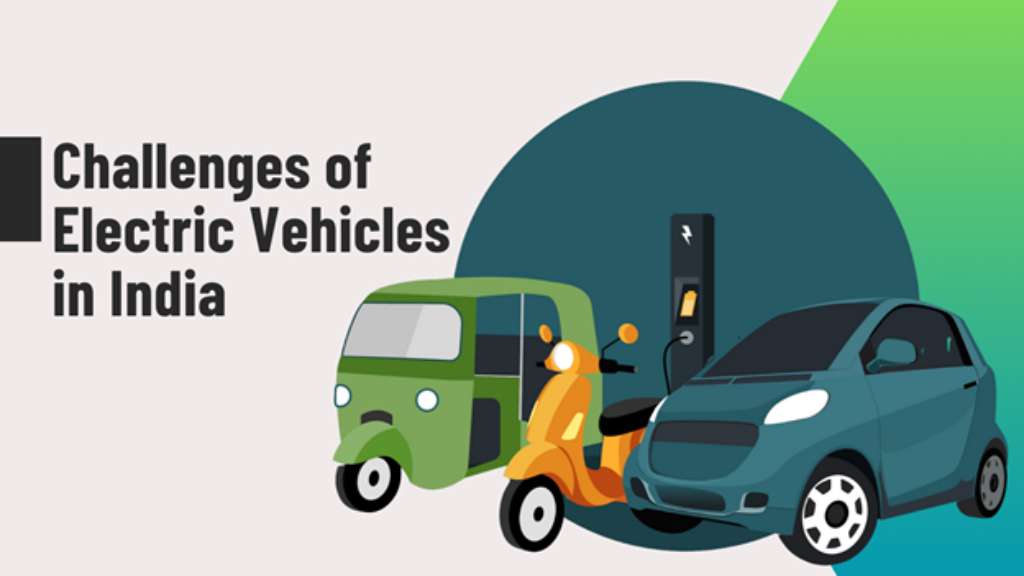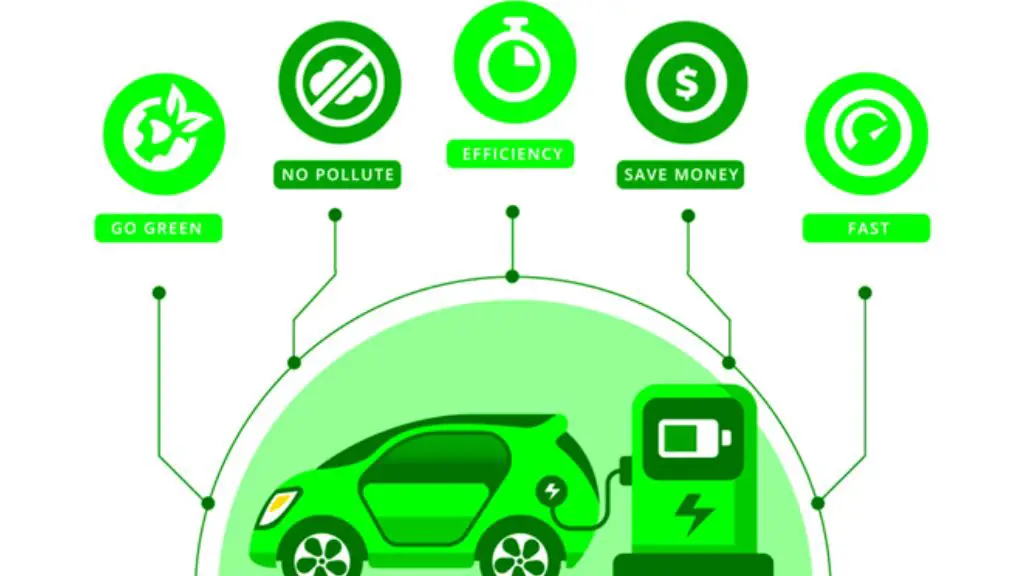Challenges of Electric Vehicles in India

Electric vehicles (EVs) have been gaining popularity worldwide as a sustainable and eco-friendly mode of transportation. India is also witnessing a growing interest in EVs as the country strives to reduce its carbon footprint and dependence on fossil fuels.
However, despite the potential benefits of EVs, several challenges need to be addressed for successful EV adoption in India. This article explores the Challenges of EV Revolution faced in the adoption in India and discusses potential solutions.
What are electric vehicles, and why are they important?
Electric vehicles, also known as EVs, are automobiles powered by electric motors rather than internal combustion engines. EVs store electrical energy in rechargeable batteries and use it to propel the vehicle. The importance of EVs lies in their ability to reduce greenhouse gas emissions and reliance on fossil fuels. By shifting from conventional gasoline-powered vehicles to EVs, countries like India can reduce air pollution, improve energy efficiency, and mitigate the effects of climate change.
What are the benefits of EVs?
Before delving into the challenges, it is crucial to highlight the benefits of EVs to understand their potential impact in India. Some key advantages of EVs include:
- Environmental sustainability: EVs produce zero tailpipe emissions, improving air quality and reducing greenhouse gas emissions.
- Energy efficiency: EVs are more energy-efficient than combustion engine vehicles. They convert a higher percentage of energy from their batteries to power the vehicle, reducing energy consumption.
- Reduced reliance on fossil fuels: EVs can help diversify the energy mix by relying on electricity generated from renewable sources, decreasing dependence on fossil fuels and improving energy security.
- Lower operating costs: EVs have fewer moving parts and require less maintenance than conventional vehicles. This translates into reduced maintenance and operational expenses.
- Potential for grid integration: EVs can contribute to grid stability by acting as distributed energy storage units. They can charge during off-peak hours and discharge extra energy during peak demand, helping to optimize the electricity grid.
High upfront cost
One of the primary challenges hindering the widespread adoption of EVs in India is the high upfront cost. EVs tend to be more expensive than internal combustion engine vehicles primarily due to the cost of lithium-ion batteries, which constitute a significant portion of the vehicle’s total cost. High battery manufacturing costs and limited scale economies make EVs comparatively costlier.
To address this challenge, concerted efforts are required to promote domestic battery manufacturing in India. The government, in collaboration with research institutions like the Department of Heavy Industry, NITI Aayog, and Indian Institutes of Technology, can play a significant role in nurturing indigenous battery manufacturing capabilities. This would lead to cost reduction and reduce currency fluctuations and dependence on imports.
Limited range anxiety
Limited driving range anxiety is another crucial challenge that inhibits the adoption of EVs in India. Electric vehicles have a limited driving range compared to gasoline-powered vehicles. This limitation stems from the current state of battery technology, which needs help with energy storage density. Consequently, EV owners may experience anxiety regarding the availability of charging infrastructure during long trips.
To mitigate this challenge, it is crucial to establish a robust and widespread charging infrastructure network across India. The government, in collaboration with entities like the Ministry of Road Transport and Highways, Bureau of Indian Standards, and Central Electricity Authority, should develop policies and guidelines that incentivize the creation of public charging stations. Working closely with public sector companies such as the Power Grid Corporation of India and Energy Efficiency Services Limited, investments should be made in establishing charging stations, particularly along highways and major routes. This would help address range anxiety and encourage potential EV buyers.
Limited charging infrastructure
Related to the limited driving range is the challenge of limited charging infrastructure in India. As of today, the charging infrastructure network is still in its nascent stage of development. Although several charging stations are present in major cities, their availability is limited in smaller towns and rural areas.
To overcome this challenge, concerted efforts are needed by public and private actors. Government agencies like the Ministry of Road Transport and Highways and Bureau of Indian Standards should develop regulations and guidelines to accelerate the process of setting up charging stations. Collaboration with private companies such as Indian Oil Corporation and Bharat Heavy Electricals Limited can facilitate the establishment of charging infrastructure, utilizing their existing network of petrol pumps and electric equipment manufacturing expertise.
Lack of consumer awareness and education
The lack of consumer awareness and education regarding EVs is another barrier to their adoption in India. Many Indian consumers are not fully aware of the benefits of EVs, the range of models available, and how to use them effectively. This lack of awareness inhibits consumer confidence and contributes to a slow adoption
Contributes to a slow adoption rate
To address this challenge, a comprehensive awareness and education campaign is necessary. Entities like the Electric Vehicle Association of India (EVAI) and the Society of Indian Automobile Manufacturers (SIAM) can be vital in disseminating information about EVs to the general public. Additionally, collaboration with research institutions such as the Indian Institutes of Technology and the National Automotive Testing and R&D Infrastructure Project (NATRiP) can support the development of educational programs and training modules to enhance consumer awareness and understanding of EVs. These efforts can include workshops, seminars, and campaigns through various media channels, targeting different population segments.
Other challenges
In addition to the key challenges mentioned above, EVs face several other obstacles in India. These include:
- Lack of standardization in charging ports: The absence of standardized charging ports across different EV models makes it inconvenient for EV owners and limits interoperability. Efforts should be made to establish uniform charging standards, ensuring compatibility and ease of use for consumers.
- High import duties on EV components: Current import duties on key EV components, such as batteries and electric motors, contribute to India’s high cost of EVs. Reducing import duties or incentivizing domestic manufacturing of these components can bring down the overall cost and promote the growth of the EV industry.
- Limited availability of EV models: The limited availability of electric vehicle models in India hampers consumer choice and slows the adoption rate. Encouraging domestic and international automakers, such as Tata Motors, Mahindra & Mahindra, Hero Electric, Ather Energy, and Ola Electric, to introduce a wider range of electric models in the Indian market can help address this challenge.
- Lack of skilled EV technicians: The servicing and maintenance of EVs require specialized knowledge and skills. However, there is a need for more trained EV technicians in India. Collaboration between the government, private companies, and research institutions can help establish training programs, certification courses, and vocational training centers to address this skill gap and create a skilled EV technician workforce.
Case Studies of Successful EV Adoption in India
It is important to highlight successful case studies of EV adoption in India to showcase the potential and benefits of EVs in the country. Several initiatives have been launched to promote the use of electric vehicles. One such example is the “FAME India” (Faster Adoption and Manufacturing of Electric Vehicles in India) scheme launched by the Indian government. Under this scheme, financial incentives and subsidies are provided to buyers of EVs, making them more affordable and encouraging adoption.
Additionally, companies like Tata Motors, Mahindra & Mahindra, and Hero Electric have made significant strides in the electric vehicle market in India. Tata Motors has introduced attractive and affordable electric models like the Tata Nexon EV, which has gained popularity among Indian consumers. Mahindra & Mahindra’s electric vehicles, such as the Mahindra eVerito and the Mahindra eKUV100, have also positively contributed to EV adoption. Furthermore, Hero Electric, a leading electric two-wheeler manufacturer in India, has successfully positioned itself as a reliable and affordable choice for electric scooters.
These case studies demonstrate that the adoption of EVs can thrive in India with the right policies, incentives, and attractive product offerings.
Role of the Government in promoting EV adoption in India
The government of India has recognized the importance of electric vehicles and has taken several steps to promote their adoption. In collaboration with various government agencies, the Ministry of Road Transport and Highways has been instrumental in formulating policies and regulations to encourage EV adoption and create an enabling environment for the EV industry.
The government’s interventions include financial incentives for EV buyers, tax exemptions, and subsidies for EV manufacturers. The “FAME India” scheme, mentioned earlier, provides incentives and subsidies to buyers of EVs and supports the development of the necessary infrastructure. Additionally, the government has set an ambitious target to achieve 30% electric vehicle penetration by 2030 and is investing in research and development to nurture domestic battery manufacturing capabilities.
Furthermore, collaboration with research institutions, such as the Indian Institutes of Technology (IITs) and the Indian Institute of Science (IISc), has been crucial in driving innovation and developing indigenous EV technology. These institutions are actively involved in research projects related to battery technology, charging infrastructure, and energy management systems for EVs.
The government’s role also extends to collaborating with public sector companies, such as Energy Efficiency Services Limited (EESL) and National Thermal Power Corporation (NTPC), to deploy EVs in public transportation, government fleets, and other sectors. These initiatives showcase the government’s commitment to leading by example and promoting EVs as viable alternatives.
Conclusion
Electric Vehicles have the potential to revolutionize India’s transportation sector. However, several challenges must be addressed to realize their full potential. Challenges such as high upfront costs, limited driving range anxiety, lack of charging infrastructure, consumer awareness gaps, and other technical and regulatory hurdles must be overcome.
These challenges can be tackled effectively through collaborative efforts between government agencies, research institutions, public and private sector companies, and industry organizations. Encouraging domestic battery manufacturing, expanding the charging infrastructure network, implementing educational campaigns, and addressing standardization issues will create an environment conducive to EV adoption in India.
With the right policies, incentives, and investments, India can lead the way in transitioning to a cleaner, greener, and more sustainable transportation system. Electrification of the automotive sector will reduce carbon emissions and air pollution, enhance energy security, and create new economic opportunities. All stakeholders must collaborate to build a robust and vibrant electric vehicle ecosystem that benefits the environment and the Indian economy.
FAQs
Are electric vehicles more expensive than gasoline-powered vehicles?
Electric vehicles have a higher upfront cost than their gasoline-powered counterparts. The high cost is primarily due to the expensive lithium-ion batteries used in EVs. However, electric vehicle costs are expected to reduce as technology improves and economies of scale are achieved.
What is range anxiety?
Range anxiety refers to the fear or concern that an electric vehicle driver may experience regarding the available driving range and the availability of charging infrastructure. Limited driving range and insufficient charging stations can contribute to range anxiety for electric vehicle owners.
What role does the government play in promoting EV adoption in India?
The government plays a significant role in promoting EV adoption in India through policy support, incentives, and the development of charging infrastructure. Government agencies such as the Ministry of Road Transport and Highways, NITI Aayog, and the Department of Heavy Industry collaborate with public and private entities to create a conducive environment for EV growth in the country.
How can the need for more consumer awareness and education about EVs be addressed?
The need for more consumer awareness and education about EVs can be addressed through comprehensive awareness campaigns, educational programs, and training modules. Entities such as the Electric Vehicle Association of India (EVAI), the Society of Indian Automobile Manufacturers (SIAM), and research institutions can collaborate to disseminate information and educate the public about the benefits and usage of electric vehicles.
What steps can be taken to address the lack of standardization in charging ports?
Addressing the lack of standardization in charging ports can be achieved through regulatory measures and industry collaboration. In coordination with industry stakeholders, the government can establish and enforce uniform charging standards to ensure compatibility and interoperability between EV models. In addition, collaboration with international standards organizations and industry associations, such as the Bureau of Indian Standards (BIS) and the International Council on Clean Transportation (ICCT), can help establish global standards for EV charging infrastructure.






